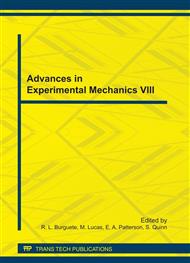p.147
p.153
p.159
p.165
p.171
p.177
p.183
p.189
p.195
Digital Image Correlation Techniques for Analysing the Deformation Behaviour of Compacted Graphite Cast Irons on a Microstructural Level
Abstract:
Digital image correlation techniques (DIC) have been used in this study to reveal how different phases (graphite, ferrite and pearlite) of compacted graphite cast irons (CGI) accommodate strains at loading. A DIC-software was used to analyse sets of successively acquired images. The images were acquired with a light optical microscope revealing the microstructure of polished and etched CGI materials at different load levels. Five CGI materials, having percentages of pearlite in the range 35 to 90 area%, were included in the study. Apart from the different matrix constituents (ferrite and pearlite) the nodularity was altered and varied from 5% to 65%. It is concluded from this study that the different phases in CGI are affected by the global strain and load to a greater or less extent. The graphite phase appears to accommodate high strains but, due to fracture of the graphite particles at relatively low strains, the resulting high strain values show the opening up of graphite cavities. The ferrite phase is subjected to a strain concentrating effect of the graphite phase and with a low nodularity, i.e., with graphite particles that are stretched out and interconnected, the effect becomes more pronounced resulting in high strains. The pearlitic phase is the strongest of the constituents within the microstructure and the lowest local strains are observed in this phase. The study shows that DIC strain-field images reveal the microstructural strain level distribution for the CGI materials. The future outlook is to use these sets of strain-field images for verification of micro mechanical finite element analysis on a microstructural scale of CGI materials.
Info:
Periodical:
Pages:
171-176
Citation:
Online since:
August 2011
Authors:
Price:
Сopyright:
© 2011 Trans Tech Publications Ltd. All Rights Reserved
Share:
Citation:


